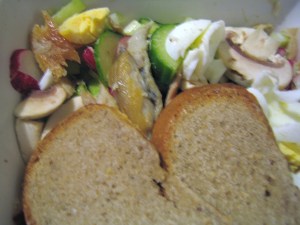The one anxiety people have when they are diagnosed with coeliac disease is the bread. People complain about the texture, the taste, the fact that sandwiches ‘are just not the same’, the slices are too small and they struggle with choices at lunchtime. In my experience most people find a solution to the bread ‘problem’ and this can be achieved by trying all different types, most
companies will allow you to sample the products. Free From shows are ideal venues to visit as most companies exhibit and will allow you to taste. It can be argued that the popularity of the gluten-free diet as a lifestyle choice is not ideal, but one thing is for sure, choices for gluten-free foods are improving all the time. Although free market competition and following price reductions due to market competition does not seem to have followed with the increasing choice available.
The fresh breads that are marketed are good options and if you can tolerate codex wheat (wheat that has had the gluten removed) but you may need to have freezer storage as if these are ordered on prescription (for people with coeliac disease only) they are delivered in larger batches. Try to choose ones with added fibre or seeds to increase wholegrain options in your diet. Some breads can be freshened by warming in an oven or microwave – this is usually stated on the packet and some versions have humectants (an additive that holds on to water) added to keep them moist, such as psyllium husk flour, which can also act as a bulking laxative! Useful for most people but you might want to limit the amount of these types of bread if you have irritable bowel syndrome and you suffer from diarrhoea and bloating.
Most types of bread are available in gluten-free varieties, such as baguettes, rolls, fruit loaf, pita and naan, a new wrap has even been introduced recently. If you use artesian bread outlets or farmers markets, please ensure contamination with gluten has been avoided and the seller is aware that spelt flour is not gluten-free. One clear problem with the gluten-free bread is that the slices are often smaller – but do be cautious as these slices may contain the same calories as a standard sized loaf. Those people who have weight management requirements need to review the labels when choosing bread as sometimes ingredients that are used to improve the texture increase the calories the bread contains. Some of the more common breads and there fat and calorie contents are below.
————–Energy per Slice/per 100g (Kcal) Fat Content per slice/per 100g (g)
Juvela Fibre Fresh 73/229 1.3/4.2
Glutafin Select Fibre Fresh 88/252 2.2/6.1
Genius brown original 82/304 3.8/14.3
Warburtons Brown 73/229 2.2/6.1
Yes You Can (fibre) 83/221 1.4/3.7
Wellfoods (fibre) –/216 –/2.3
Ener-G (rice brown loaf) –/334 –/15
Fria Fiber 83/265 2.1/7.0
Barkat Brown –/221 — /3.2
Dietary Specials 68.5/249 1.7/6.2
Biona rice brown bread –/200 –/2.0
Asda Brown 86/234 1.2/3.3
Sainsbury’s Brown (slice = 36g) 86/302 3.6/12.5
Tesco Brown 105/285 3.1/8.6
Only two of the above products would be classed as a low fat product if you go by grams of fat per 1oog only, but this is complicated, as slices are different thicknesses and sizes and calorie content is also important. Concentrating on the fat level might not be that helpful (and the calorie content of the rest of the diet too is clearly important – it’s no good complaining about the calorie content of the bread, if you consume lots of gluten free cake, biscuits and pastries!) Those examples above without per slice options may be unsliced, therefore the calorie content depends on how generous you are, thin slices or ‘door stop’ slices, as my Lancashire family would describe. Some companies are now producing loaves that have larger slices to address the issue of small slices, but again caution might need to be taken for those who struggle to maintain a healthy weight.
As can be seen above we now have lots of options for choices for bread – so those who are newly diagnosed should ideally try each version to see which they prefer, this choice can be as different as chalk and cheese! You can make your own using breadmakers and baking by hand, mixes are available to help and they are usually very good in my experience. Making your own can take some time to get used too but home-made can taste much nicer – you could add dried fruit, a source of iron and fibre. Other options are gluten-free crackers and crispbreads, good options for lunchtime and eating away from home. Toasting the bread can also make the bread more tolerable for some.
If you are following the Low FODMAP diet ensure you check ingredients.
If you have any tips for people please share!
Related articles
- How to Make Gluten-Free Bread for Sandwiches (glutenfree.answers.com)
- Gluten-free Sandwiches (greatbritishchefs.com)





I’ve been a diagnosed coeliac for about 6 yrs now, & I STILL can’t find a gluten free bread that I like, lasts longer than the day it’s opened, or doesn’t crumble when you make a sandwich (believe me, I’ve tried!) Also, the fact that I don’t like cooking or shopping makes it even more difficult. My weekly shop used to take 30mins, tops, after diagnosis, I found myself in the supermarket, tears streaming down my face due to label checking, 3hrs later. I gave up & went home. I ended up living on (expensive) shop bought gluten free cakes & biscuits, as that’s what’s most plentiful. After putting on 2 stone in weight, & suffering severe depression I went to the Dr. Now remember, I’m an atypical Coeliac, the ONLY symptoms I have are anaemia, no gut problems, eczema, etc. My Dr decided to monitor me closely, while I ate ‘normal’ food, but took iron tablets. My depression disappeared, my weight gain disappeared. I have to stress, it’s apparently, NOT usual to have no symptoms except the anaemia. I’ve had the blood test, the gut biopsy, & they’re positive for coeliac. My gp is happy for me to reduce my gluten intake, although the dietician (a very young lady who insisted I WOULD like the gluten free diet, telling a 48 yr old?) was not. To this day, I am ill less frequently, not even coughs & colds. I work outdoors in all weathers, doing heavy lifting work, & I’ve not been happier.
on October 11, 2013 at 8:37 am RonnieSJHi RonnieSJ
on October 11, 2013 at 6:34 pm JulieThank you for your honest reply, it can be very daunting when you are newly diagnosed and, as dietitians we ALWAYS advocate people need to follow the diet 100%. This is a VERY big ask, in no other area do we ask people to commit to changing fully, usually we can negotiate small changes to help, in people with diabetes or those needing to lose weight, for example. The reasons for needing to follow the diet 100% for life are the risks associated with not doing. These are malnutrition, and not just anaemia, brittle bones and other nutritional deficiencies along with a small increased risk of small bowel cancer; this drops to the same level of risk as the general population for those who follow the diet well. If you have decided by weighing up the risks and benefits that you want to reduce your gluten intake and not fully follow the diet then that is your choice, and as you say, your GP is monitoring your situation. Your story is a common one; people can find it very difficult initially, particularly those people who have no or little symptoms to give them an immediate reason to change. It is also important to try and get to see a dietitian as soon as possible after diagnosis, as struggling without assistance doesn’t help someone to accept the situation. I cannot advocate anything other than following the diet 100%, however neither am I going to suggest that you are going to ‘like’ the diet, when everyone is different, with different likes and dislikes, I assist my patients in any way I can to help them to accept their diagnosis. However in my experience, and I have been working in this area for some time and seen numerous people, most people find a solution to the bread situation. You are correct anaemia is more common as a symptom of coeliac disease and does need investigating thoroughly. Any dietitian who works in this area has, in my view, a responsibility of following the diet to learn and experience the problems that patients have. I followed the diet when I was initially employed as a gastro dietitian.